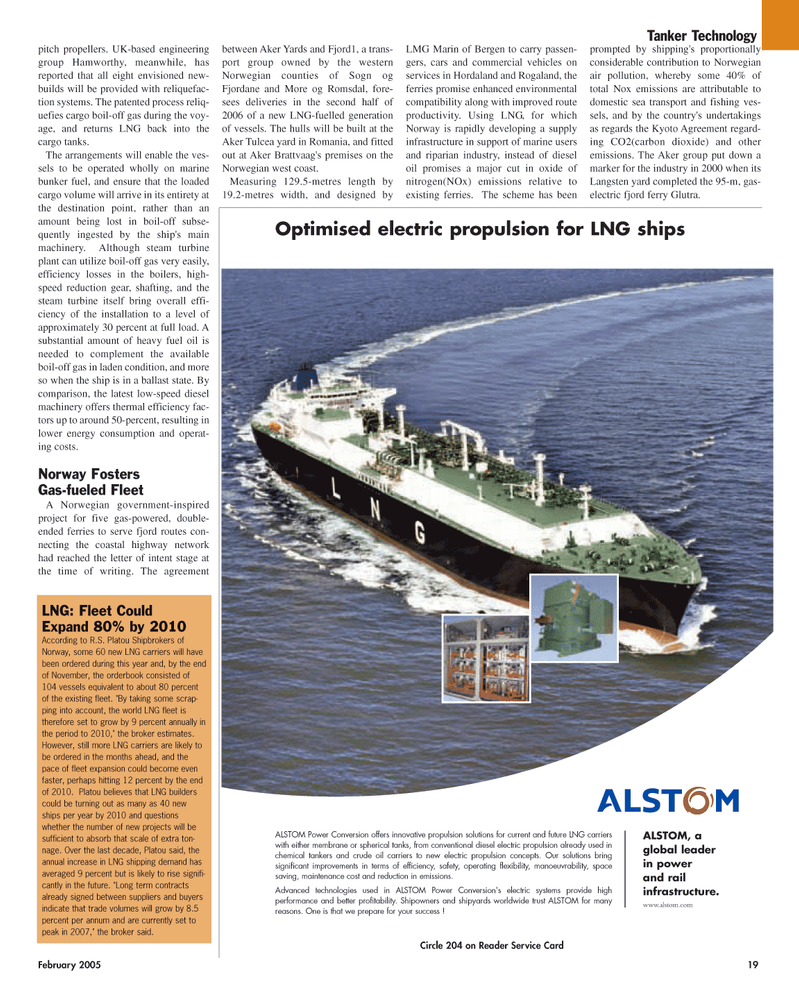
Page 19: of Maritime Reporter Magazine (February 2, 2005)
Read this page in Pdf, Flash or Html5 edition of February 2, 2005 Maritime Reporter Magazine
February 2005 19 pitch propellers. UK-based engineering group Hamworthy, meanwhile, has reported that all eight envisioned new- builds will be provided with reliquefac- tion systems. The patented process reliq- uefies cargo boil-off gas during the voy- age, and returns LNG back into the cargo tanks.
The arrangements will enable the ves- sels to be operated wholly on marine bunker fuel, and ensure that the loaded cargo volume will arrive in its entirety at the destination point, rather than an amount being lost in boil-off subse- quently ingested by the ship's main machinery. Although steam turbine plant can utilize boil-off gas very easily, efficiency losses in the boilers, high- speed reduction gear, shafting, and the steam turbine itself bring overall effi- ciency of the installation to a level of approximately 30 percent at full load. A substantial amount of heavy fuel oil is needed to complement the available boil-off gas in laden condition, and more so when the ship is in a ballast state. By comparison, the latest low-speed diesel machinery offers thermal efficiency fac- tors up to around 50-percent, resulting in lower energy consumption and operat- ing costs.
Norway Fosters
Gas-fueled Fleet
A Norwegian government-inspired project for five gas-powered, double- ended ferries to serve fjord routes con- necting the coastal highway network had reached the letter of intent stage at the time of writing. The agreement between Aker Yards and Fjord1, a trans- port group owned by the western
Norwegian counties of Sogn og
Fjordane and More og Romsdal, fore- sees deliveries in the second half of 2006 of a new LNG-fuelled generation of vessels. The hulls will be built at the
Aker Tulcea yard in Romania, and fitted out at Aker Brattvaag's premises on the
Norwegian west coast.
Measuring 129.5-metres length by 19.2-metres width, and designed by
LMG Marin of Bergen to carry passen- gers, cars and commercial vehicles on services in Hordaland and Rogaland, the ferries promise enhanced environmental compatibility along with improved route productivity. Using LNG, for which
Norway is rapidly developing a supply infrastructure in support of marine users and riparian industry, instead of diesel oil promises a major cut in oxide of nitrogen(NOx) emissions relative to existing ferries. The scheme has been prompted by shipping's proportionally considerable contribution to Norwegian air pollution, whereby some 40% of total Nox emissions are attributable to domestic sea transport and fishing ves- sels, and by the country's undertakings as regards the Kyoto Agreement regard- ing CO2(carbon dioxide) and other emissions. The Aker group put down a marker for the industry in 2000 when its
Langsten yard completed the 95-m, gas- electric fjord ferry Glutra.
Optimised electric propulsion for LNG ships
ALSTOM Power Conversion offers innovative propulsion solutions for current and future LNG carriers with either membrane or spherical tanks, from conventional diesel electric propulsion already used in chemical tankers and crude oil carriers to new electric propulsion concepts. Our solutions bring significant improvements in terms of efficiency, safety, operating flexibility, manoeuvrability, space saving, maintenance cost and reduction in emissions.
Advanced technologies used in ALSTOM Power Conversion's electric systems provide high performance and better profitability. Shipowners and shipyards worldwide trust ALSTOM for many reasons. One is that we prepare for your success !
ALSTOM, a global leader in power and rail infrastructure. www.alstom.com
Circle 204 on Reader Service Card
LNG: Fleet Could
Expand 80% by 2010
According to R.S. Platou Shipbrokers of
Norway, some 60 new LNG carriers will have been ordered during this year and, by the end of November, the orderbook consisted of 104 vessels equivalent to about 80 percent of the existing fleet. "By taking some scrap- ping into account, the world LNG fleet is therefore set to grow by 9 percent annually in the period to 2010," the broker estimates.
However, still more LNG carriers are likely to be ordered in the months ahead, and the pace of fleet expansion could become even faster, perhaps hitting 12 percent by the end of 2010. Platou believes that LNG builders could be turning out as many as 40 new ships per year by 2010 and questions whether the number of new projects will be sufficient to absorb that scale of extra ton- nage. Over the last decade, Platou said, the annual increase in LNG shipping demand has averaged 9 percent but is likely to rise signifi- cantly in the future. "Long term contracts already signed between suppliers and buyers indicate that trade volumes will grow by 8.5 percent per annum and are currently set to peak in 2007," the broker said.
Tanker Technology
MR FEBRUARY 2005 #3 (17-24).qxd 2/2/2005 9:30 AM Page 3

 18
18

 20
20
